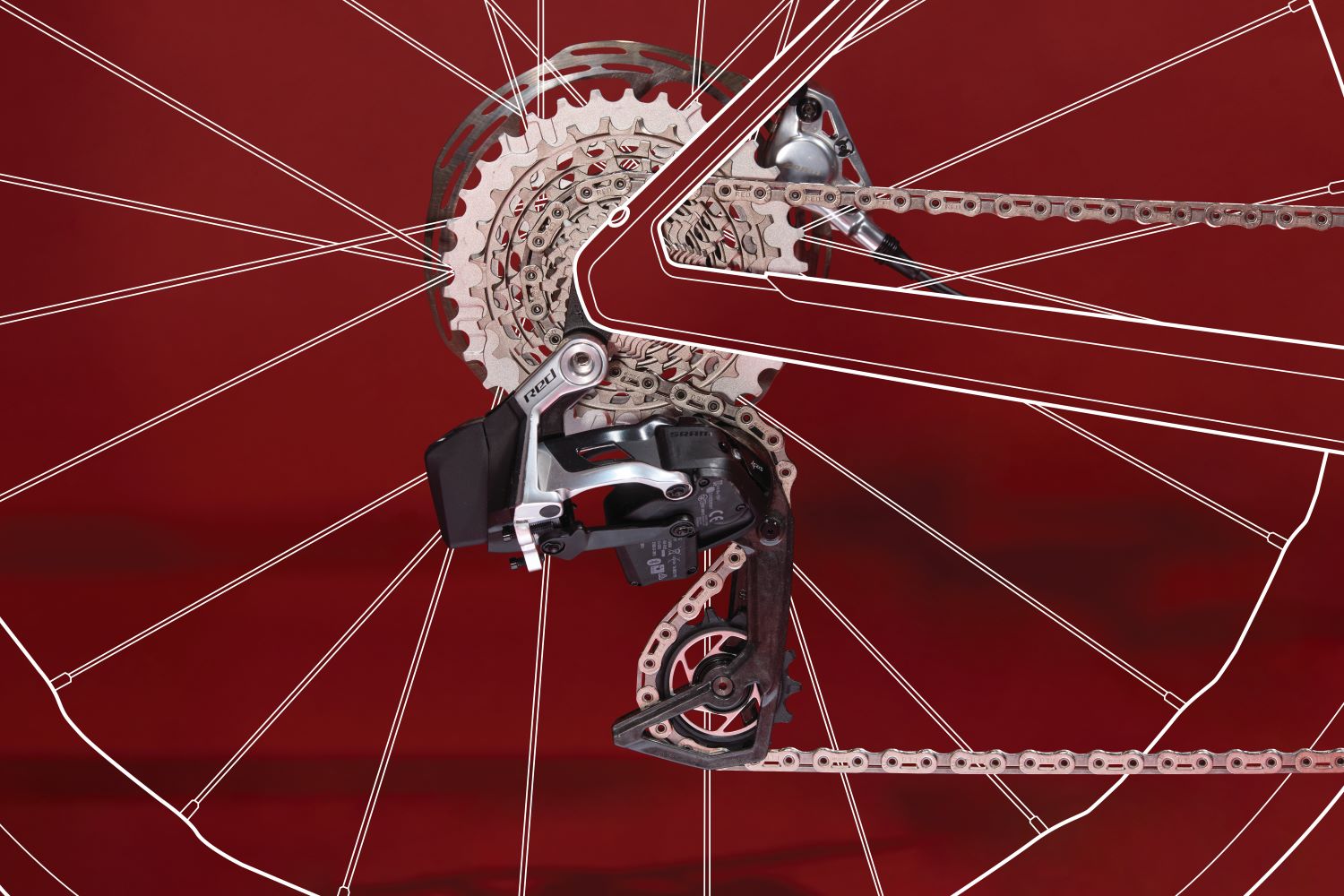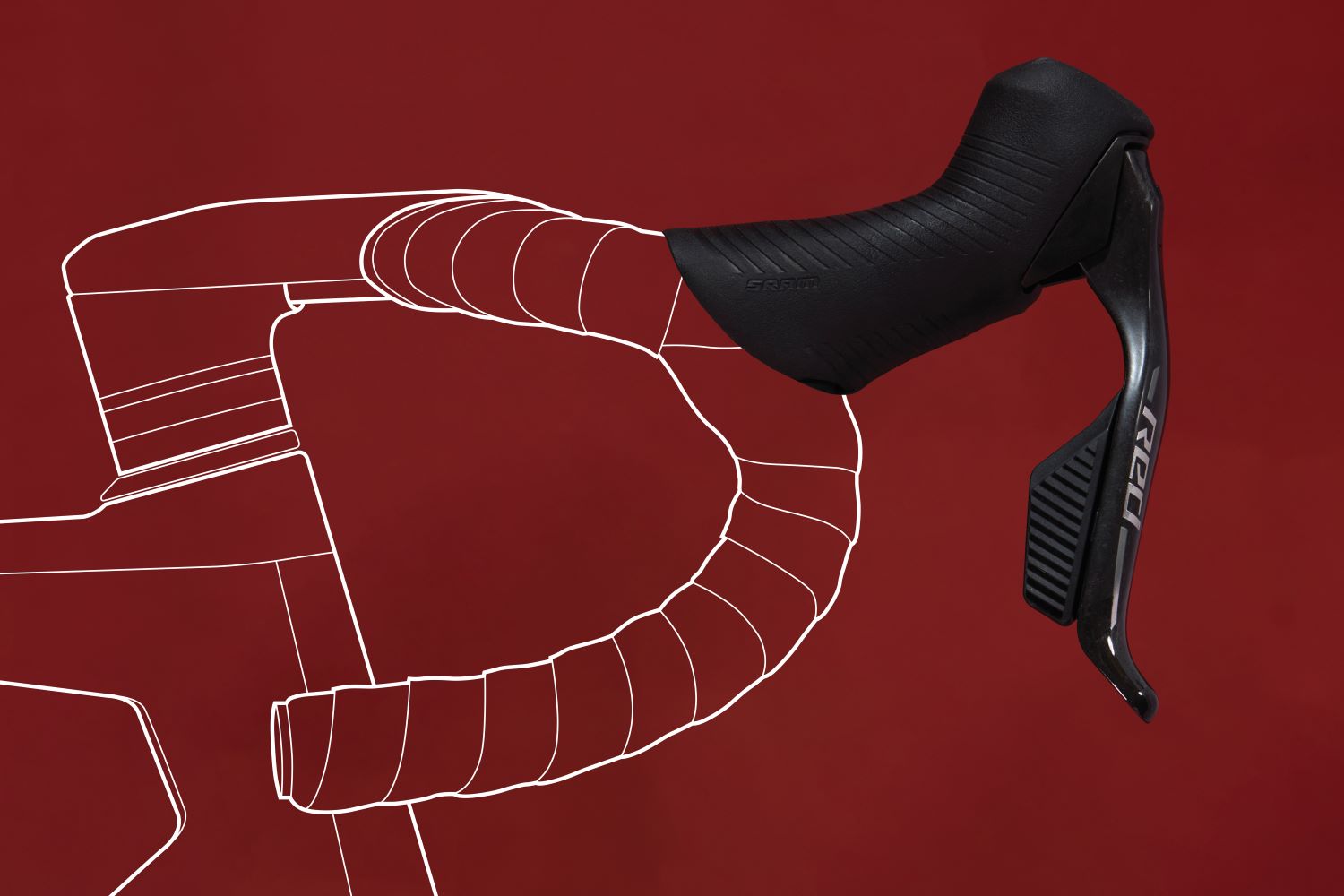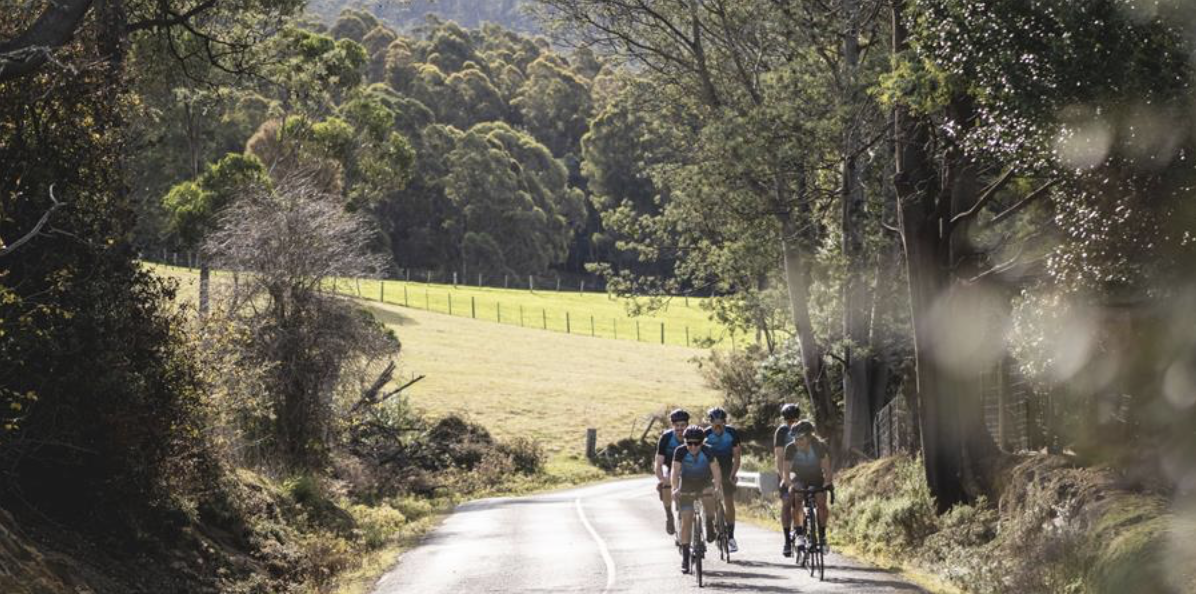Sram has revealed its new Red AXS groupset, and this time round the focus is on lighter RED weight and better ergonomics

Words SAM CHALLIS Photography TAPESTRY
If you were to take a look at any hill climb event in the past 10 years and see what bikes were being raced, you’d notice that Sram’s old Red22 mechanical rim-brake groupset is the most common choice on the more committed builds.
And it’s not because of the groupset’s shifting and braking capabilities (hill climbers don’t do much of either), but rather because of the weight.
When it appeared in 2013, Sram Red22 weighed in at 1,741g, which trumped its rival Campagnolo Super Record by over 200g and Shimano Dura-Ace 9000 by half that again.
While subsequent redesigns of Red have increased its functionality, such as by introducing disc brakes, wireless electronic shifting and a 12th sprocket, they have also increased its weight to the extent that an equivalent Dura-Ace arrangement has been lighter for a couple of generations now.
However, while it may never again get down to the dizzyingly light weights of old, the latest Red revision means Sram can once again claim the title of lightest groupset.
Give by taking away
‘While it’s dependent on exact setup, new Red AXS is 2,496g,’ says Jason Fowler, Sram’s road drivetrain product manager.
‘That’s 153g lighter than the previous version, and around 66g lighter than similarly specced Dura-Ace.’
Looking closely at the more skeletal appearance of the new Red groupset, it’s easy to see where Sram has made the incremental gains necessary to achieve that weight loss.
Cut out chain links contribute 13g; the carriers at the centre of the new Paceline X rotors are more aggressively pared back; shoulder sections of the brake callipers have been removed; and the outer plate of the rear derailleur’s parallelogram has been hollowed out (a feature that would no doubt appeal to the hill climbers who have unofficially done similar to their Red22 derailleurs).
Hidden in the tweaked carbon layup of the crank arms, Sram found another 29g, but by far the biggest contributor to Red’s weight loss has been at the levers, which the brand says have dropped 41.5g each.
‘That’s a considerable saving so high up on the bike,’ says Fowler.
‘It becomes apparent in the swing weight when climbing on the hoods.’
Yet it will be the revised ergonomics of the controls that will be more tangible to riders.
‘We were happy with the shape of the last-generation levers, and they’ve remained a success to this day – Sram Red was used by all six Grand Tour winners last year – but we knew it was an area we could develop,’ says Fowler.

‘Ergonomics aren’t something you can really model on a computer, though.
Real rider feedback was essential, and it has been a four-year process to update the controls’ shape.’
Most obviously, the pommel of the controls is much smaller.
The body is longer by around 6mm too.
‘This is to make them more comfortable to grip when riding on the hoods,’ says Fowler.
‘The smaller pommel fits in the hand more comfortably, and the longer body allows more space for finger wrap underneath.’
This was achieved by shifting the piston arrangement inside the control body.
It has gone from a vertical pull-piston in the pommel, where squeezing the brake lever pulls the piston downwards to compress the hydraulic fluid and actuate the brakes, to a horizontal push-piston inside the lever body.
‘Rearranging things like this, as well as reshaping the brake levers themselves, also allowed us to manipulate braking modulation.
The lever pivot could be much higher to create more leverage.
Along with moving where the brake calliper applies pressure to the rotor further outboard, for the same force it now takes a fifth less effort to brake from the hoods and a third less effort from the drops.’
How and where the braking power is applied isn’t set in stone either, as the levers possess independent adjustment of reach (how far the brake levers sit away from the bars) and contact point (when in the lever travel the brakes engage).
Sram says there should be plenty of scope for both, because the shift paddles are now slimmer and longer to give more free space between lever and bars.
Shifting gears
The last time Sram updated Red, the groupset went to 12-speed.
That introduced Sram’s X-Range gearing concept, which uses a 10t smallest sprocket and more compact chainrings in an attempt to create both close steps and more range.
The groupset also served as the starting point for three overhauled tiers below it, as well as the extension of Sram’s mix-and-match AXS concept into its road portfolio.
It was a biggie, so while it would be fair to say this new groupset’s weight and ergonomic changes validly grab headlines, ultimately it’s simply a step on from the last generation’s step change.
That is reflected in the gearing this time round.
While there are some cosmetic changes in the machined one-piece chainrings, they are offered in the same three pairings (with three extra available aftermarket) and the manufacturer continues with its integrated power meter.
‘I know we’ve taken flak for not making it separate to the rings, but the longer we’ve persevered with the design the more evident it has become that it’s simply not an issue.

Our chainrings just don’t really wear out, so the return rate of consumed units has been incredibly low,’ says Fowler.
New cassettes have been added, with 10-30t and 10-36t options doubling the number of ratio choices on offer, all using the one-piece machined steel X-Dome construction.
Sram’s ‘Rainbow’ anodised finish is now an option across the board too, chain included.
‘We see it in our AXS app data that the 10t is used a lot by pros, not just in sprints but on descents too, but we wanted to offer more options for climbing,’ says Fowler.
‘It’s common knowledge that riders such as Jonas Vingegaard and Wout van Aert have been pairing the 10-36t with our Red 1x chainring as well.’
Despite the extra ratios, all drivetrain setups are accommodated by just a single rear derailleur now.
Sram’s well-regarded Orbit Fluid damper is carried over to keep the chain under control, but the pulley wheels have been pepped up: they are now larger and come with hybrid ceramic bearings.
Some consumers may tell you that front shifting has historically not been Sram’s greatest strength, so Fowler says this was an area of focus.
‘I’d say the first time a rider uses new Red they’ll notice the ergonomics, then the braking, and the front shifting not long after,’ he says.
‘It’s faster and more precise thanks to a narrower cage, but there won’t be any risk of rasp because it also has an auto-trim feature, so will micro-adjust depending on where the chain is on the cassette.’
The digital age
As soon as derailleurs and shifters went from communicating via cables, ratchets and springs to wireless protocols and servos, the potential for head units to play a key part in the function of a groupset became evident.
Sram is the first to fully exploit that promise, as new Red is the first groupset to be co-developed with a head unit.
Hammerhead was acquired by Sram in 2021, so the tech brand’s latest Karoo computer and Sram’s flagship groupset could be developed in-house simultaneously.
‘The latest Karoo remains an incredible computer in its own right, but functions on another level with Red,’ says Fowler.

‘It connects to the groupset automatically, letting you configure shift settings directly from your bars or assess battery status.
It works both ways too: the Red hoods have “Bonus Buttons” on the inside of the pommels that can be set to control pages on the Karoo.’
The computer will be supplied as standard with the groupset when it’s bought aftermarket, and appears as OEM equipment on stock bikes too.
Customers shouldn’t have to search too hard to find it, either.
With the exception of one or two leaks, new Red has gone from being nowhere to everywhere: more than 40 bike brands already offer builds and all Sram’s men’s and women’s pro road teams are now racing on it.
Old Red22 might still dominate the niche of hill climbs, but new Red AXS is set to take on everywhere else.
THE SPEC
Model Sram Red AXS
Price $7,890 with power meter, $7,030 without power meter (both include the new Karoo, which is $750 on its own)
Weight 2,496g
Chainring pairings 46/33, 48/35, 50/37, 52/39, 54/41, 56/43
Crank arm lengths 160mm, 165mm, 170mm, 172.5mm, 175mm
Cassette ratios 10-28t, 10-30t, 10-33t, 10-36t
Rotor sizes 160mm, 140mm


